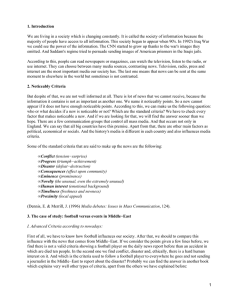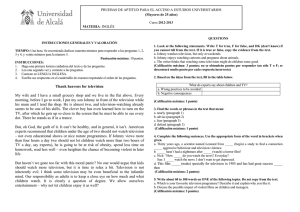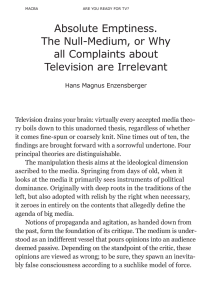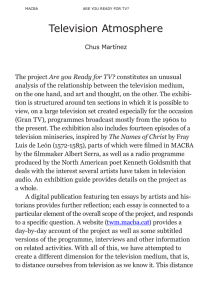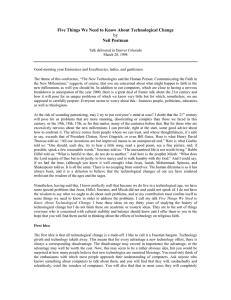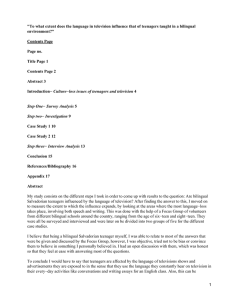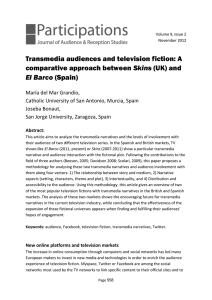New Television Narratives: Entertainment, Telling, Citizenship
Anuncio
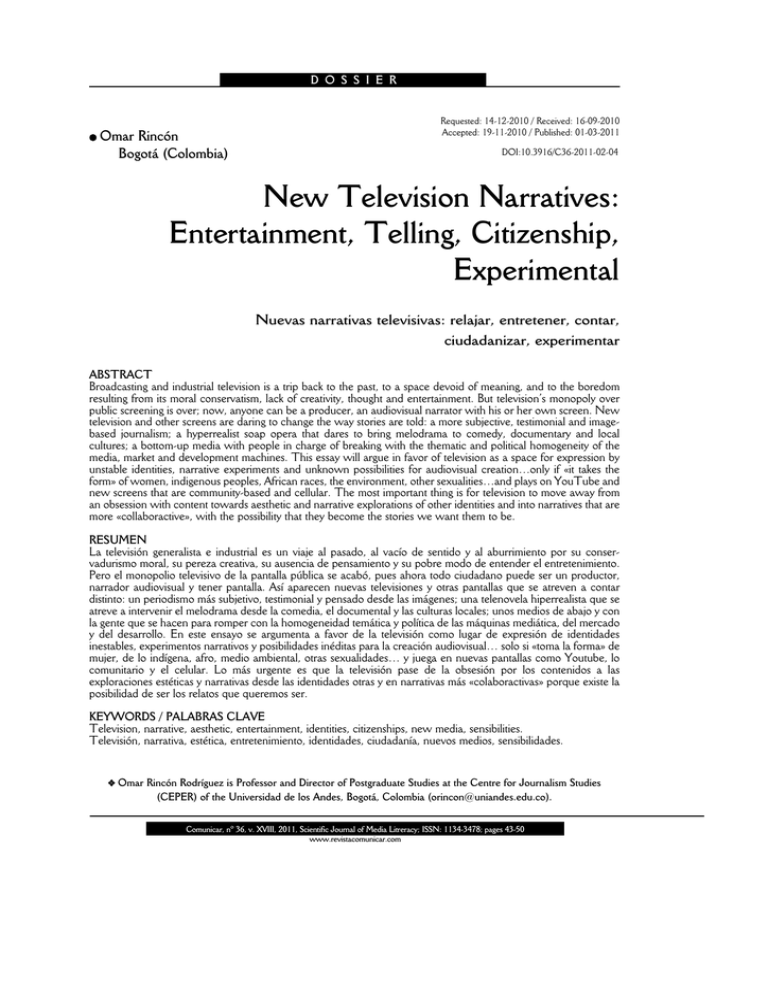
D O S S I E R l Omar Rincón Bogotá (Colombia) Requested: 14-12-2010 / Received: 16-09-2010 Accepted: 19-11-2010 / Published: 01-03-2011 DOI:10.3916/C36-2011-02-04 New Television Narratives: Entertainment, Telling, Citizenship, Experimental Nuevas narrativas televisivas: relajar, entretener, contar, ciudadanizar, experimentar ABSTRACT Broadcasting and industrial television is a trip back to the past, to a space devoid of meaning, and to the boredom resulting from its moral conservatism, lack of creativity, thought and entertainment. But television’s monopoly over public screening is over; now, anyone can be a producer, an audiovisual narrator with his or her own screen. New television and other screens are daring to change the way stories are told: a more subjective, testimonial and imagebased journalism; a hyperrealist soap opera that dares to bring melodrama to comedy, documentary and local cultures; a bottom-up media with people in charge of breaking with the thematic and political homogeneity of the media, market and development machines. This essay will argue in favor of television as a space for expression by unstable identities, narrative experiments and unknown possibilities for audiovisual creation…only if «it takes the form» of women, indigenous peoples, African races, the environment, other sexualities…and plays on YouTube and new screens that are community-based and cellular. The most important thing is for television to move away from an obsession with content towards aesthetic and narrative explorations of other identities and into narratives that are more «collaboractive», with the possibility that they become the stories we want them to be. RESUMEN La televisión generalista e industrial es un viaje al pasado, al vacío de sentido y al aburrimiento por su conservadurismo moral, su pereza creativa, su ausencia de pensamiento y su pobre modo de entender el entretenimiento. Pero el monopolio televisivo de la pantalla pública se acabó, pues ahora todo ciudadano puede ser un productor, narrador audiovisual y tener pantalla. Así aparecen nuevas televisiones y otras pantallas que se atreven a contar distinto: un periodismo más subjetivo, testimonial y pensado desde las imágenes; una telenovela hiperrealista que se atreve a intervenir el melodrama desde la comedia, el documental y las culturas locales; unos medios de abajo y con la gente que se hacen para romper con la homogeneidad temática y política de las máquinas mediática, del mercado y del desarrollo. En este ensayo se argumenta a favor de la televisión como lugar de expresión de identidades inestables, experimentos narrativos y posibilidades inéditas para la creación audiovisual… solo si «toma la forma» de mujer, de lo indígena, afro, medio ambiental, otras sexualidades… y juega en nuevas pantallas como Youtube, lo comunitario y el celular. Lo más urgente es que la televisión pase de la obsesión por los contenidos a las exploraciones estéticas y narrativas desde las identidades otras y en narrativas más «colaboractivas» porque existe la posibilidad de ser los relatos que queremos ser. KEYWORDS / PALABRAS CLAVE Television, narrative, aesthetic, entertainment, identities, citizenships, new media, sensibilities. Televisión, narrativa, estética, entretenimiento, identidades, ciudadanía, nuevos medios, sensibilidades. v Omar Rincón Rodríguez is Professor and Director of Postgraduate Studies at the Centre for Journalism Studies (CEPER) of the Universidad de los Andes, Bogotá, Colombia ([email protected]). Comunicar, nº 36, v. XVIII, 2011, Scientific Journal of Media Litreracy; ISSN: 1134-3478; pages 43-50 www.revistacomunicar.com Comunicar, 36, XVIII, 2011 44 We are no longer amused by the enjoyment, pleasures, stories, aesthetics, politics and content served up by television. Television bores us. And it was supposedly made for entertainment! We flee; some of us to cable, to the Internet, to Facebook, to YouTube, to Twitter, many to the cell phone, fewer to books, and others go abroad to get to know other cultures. We all flee because the TV stations and their producers abuse their broadcasting power and produce stupid entertainment, information at the service of the power holders, fiction with bad acting, poorly dramatized formats, forgettable information… And the excuse is that television is a conservative, restrained communication media in order to boost ratings by neither morally, creatively or narratively offending the viewer. Television has profound problems in the way it tells stories, in its contents and politics: it does not entertain or seduce, or make you think. But it does make money. Open-signal television has lost its value as «family entertainment». And it is not a matter of a lack of talent or possibilities of expression, but rather too many executives and businessmen selling us off «as audiences», executives who do not watch television and believe you have to dumb down the screen in order to gain viewers. For them, the world becomes a set of marketing formulas. These executives are a virus that is gradually converting the mass television screen into a void, a desert, a collective frustration. The result: confused executives and disillusioned television viewers. The only thing they achieve is to make us flee further. The good news is that a multiple audiovisual media are emerging that can better adapt to each one of us: they take the form of what is being told – a narrative and aesthetic revolution. 1. The reinvention of television Television is industrial in its processes, logic and forms of narration; its purpose in society is to relax, entertain and generate conversation. Its rebelliousness was made possible by YouTube and inspired by feminism, indigenous studies, citizen studies, the youth and others; it was revolutionized through the Internet, the cell phone and video because we acquired the capacity to participate in the screens and stories. The television that was meant for everyone has failed to excite. New television follows the structure of hypertext and flow, where one program is mixed with another, where what happens in a soap opera or reality show becomes daily news and becomes a documentary of our time. We are moving from a primitive television that has been poorly copied from the film model or in the image of old-fashioned journalism, to another that appears more like talk shows, reality shows, docudramas, video clips and landscape TV. Its tone is more exhibitionist, truculent and daring. Morals are no longer determined by the producers but rather by the viewers. Everything flows and is consolidated into one; there are no longer programs, or channels, or television – we inhabit the narrative burst of audiovisuals. We live in a time of screen multiplicity, the business of formats, the logic of other emotions, the burst of audiovisual narratives, the multiplication of aesthetics, the diversity of awareness/identities – times in which each of us can make whatever we want out of television. What is meaningful is what is close, vital, emotional and unexpected. Truth is somewhere else, in a space that is neither Western nor male, but of other cultures. And the oral nature of the soap opera is mixed with Facebook images, YouTube mini-stories with an infinite number of aphorisms in Twitter, the Blackberry network with Skype and text messaging. We inhabit the multiplication of signals, and there is a channel for every interest, every population and every faith. And everything becomes apt to be televised, no longer imitating film or artistic video, but rather television. For this reason, we talk about ourselves in terms of «zapping, surfing, scratching, zipping, DVD, linking». «TV zapping», the mindless exercise of changing channels only to return to the same place we started off at. «TV surfing»: changing the channel while following a wave: sports, culture, children’s shows, fiction, music, or pressing the fast forward button. «TV scratching»: the practice of introducing images and TV personalities in order to discover other values, bringing them again to light and discovering their multiple cynicisms. «TV-zipping»: going deeperdeeper-deeper into an idea, an image, a character, a tone in order to enjoy brief moments of ecstasy. «TV DVD», or when we decide to watch whatever we feel like watching. «Linking» videos in YouTube and to any other screen. Audiovisual diversity made up of hysteria, repetitions, fragments, spontaneity. The audiovisual screens cry out once again and turn life into infinite entertainment; the celebration of pleasurable experiences and sentimental cultures. A television narration that documents a hysterical attitude (always overacted; always on camera, excited); aesthetics of repetition (variations of the same, for relaxed pleasure); a fragmented narration (creating the illusion of continuity on the basis of autonomous situations); an © ISSN: 1134-3478 • e-ISSN: 1988-3293 • Pages 43-50 everyday style (as if everything were live and spontaneous, and the viewer was right). The new televisions are an invitation to nomadism, to unstable identities, to ephemeral senses, to telling through images while we are living, to nonlinear transformation, the multiplayer rebirth, the virtuous perception, the visionary memory, the public creativity, the sustainable emotion and «body sense»1. All forms of television are possible. Mass television is what we will not watch. Only religion and football will be left to mass, industrial television; for everything else a camera and a story will do. We inhabit the opulence of expressive diversity. Question: Are we ready to tell our stories? 2. Telling, narrating, experimenting And the trend is to narrate. In order to narrate, we must recognize that each device is unique, and we have to learn/know how to narrate while respecting each specificity (film, TV, video, Internet, cell phone) and have something to tell (giving meaning to the life experience). Film will continue to light the path of celebrities but it will have little impact on the social life of ordinary people; everything looks bourgeois and from another time in the movies. Their language, logic, genres, duration, glamour and narrative model have fewer and fewer adherents. Film will continue to exist in its own church and with its own believers. It will continue to be one of the main areas of audiovisual study at universities; directors and authors, instead of gaining the art, will continue moving from festival to festival; their great works (no more than 10 a year) will make us think and imagine better. But either way, film will lose its hegemony and will no longer continue to impose its language and discourse on other audiovisual devices. Now we have to practice a multiplicity of screens, and begin to search for how each screen narrates, what the criteria of temporality, image, sound, rhythm, duration, genre and format are. The narrative specificities of each audiovisual device and each teller must be found. We must begin to think about each screen and how it contributes a narrative and discourse, which the following chart explains2. Each community is an audience. The industrial is an idea that is history, which constructs a format and is brought to the market. The format is an idea, with a way of producing according to set criteria of aesthetics and philosophy, in a specific dramaturgy with a storytelling style and ways of marketing. Each country, culture and society with their audiovisual knowledge will adapt the format to the interests/traditions/ sensibility of their citizens. On open-signal television and cable, the winning format is the series, fictional works concentrated in a few chapters. The best audiovisual product on offer is on cable, and its «avant-garde» is HBO; it is not television or film, but cult series that create global audiences and require a different type of television viewing3: watching with concentration, becoming a fan of each series, assuming audiovisual intelligence, paying for moral exploration (all topics), aesthetics (each series is a unique work) and narrative (complexity and choral stories). Additionally, the door is opened for made-for-TV movies that reintroduce film knowledge but with less pretension and more narrative heartiness. Documentary formats reign supreme when they seduce in the form of fiction and convert life into a story (something like a reality show). And with the arrival of digital television comes the emphasis on searching for other genres and narrative tones for children’s shows, fantasy, eroticism, cultural, everyday life; these niches that had been abandoned in the name of the «masses» are now back in business to tell, gain and exploit industrially. 3. News as storytelling The big news story in journalism in 2010 was that CNN was losing the ratings war. The informative television model has changed in form, style and CRITERIA FILM TELEVISION VIDEO INTERNET CELL PHONE Communication Ritual Watching Actor Production Duration Image Language Expressive Going to mass Dreaming Author Slow 90 minutes Wide angle Art Informative Praying the rosary Seeing Artisan Fast 30 or 60 minutes Close up Conversation Artistic Angels Searching Experimenter Personal Diverse Mobile Resistance On network New era Connection User On demand Fragment Close Contextual Intimate Celebration of «I» Flow Subject Live Instantaneous Unstable Personal © ISSN: 1134-3478 • e-ISSN: 1988-3293 • Pages 43-50 Comunicar, 36, XVIII, 2011 45 Comunicar, 36, XVIII, 2011 46 agenda, and CNN do not want to admit it (or Telesur, or any world or national news channel in our countries). In these times, no-one wants news «that appears» neutral, they want explicit subjectivity like on FOX News; the USA power agenda is no longer interesting, the empire is already a phenomenon of a past when there was supposedly only one world. Today, viewers want to be kept up-to-date with local news, with territory and perspective; before, there was only CNN, and now there are many news sources (including surprisingly, Aljazeera) and the Internet, Twitter, YouTube and the cell phone, which are more reliable. The model for informing and doing journalism CNN-style is out-dated: serious poses, faces of and more context and diversity of comprehending reality. If we do not change the informative television models, people will continue to flee from information, and we will be left with sensationalist news stories of death-accidents, sports-success and celebrities-sex which is the formula for success in television. The good news is that there are new journalistic narratives. A case in particular is Guillermo Prieto, better known in Columbia as Pirry, who hosts a weekly program that is somewhere between a personal report and a television documentary for the RCN Channel, generating good ratings and better social conversation. His television talent is in discovering the narrative of existence, delving more into daily life and talking about the common man. His Ten Command-ments4 for producing reality television would be: • Try a decent narrative on television: beyond the facts, We live in a time of screen multiplicity, the business of telling with images and formats, the logic of other emotions, the burst of audiovisual transmitting emotion. • Stories are conceived narratives, the multiplication of aesthetics, the diversity of from research and images. • Stories are told from a awareness/identities – times in which each of us can make subjective viewpoint and as an whatever we want out of television. What is meaningful is expression of opinion. • You have to try literary what is close, vital, emotional and unexpected. journalism on television: novelize without inventing. • Don’t be repetitive; aim for innovation in topics, points appearance-truth, adulation of images in themselves, of view and subjects. • You must go to the movies, where you can find screens with telephone diagrams, reports from hotels, ideas and narrative lessons. interviews with experts that talk about themselves, all • You must read, only then will you learn to tell dressed in the same clothes, hairstyles and smiles. stories and write better. Images without stories, only documentary images freely • Television is an act of writing for the ear, and it given by nature or warriors are saved. This CNN-style must be spoken like people speak. journalism is no longer valid, and business looks bad. • It must be personalized, take a position without The news is that you have to experiment with desecrating history. other models of journalistic narration and other • The only thing that you have to do is to tell analyses of information; that you have to ditch the stories, hopefully other types of stories. supposed objectivity (which is always misleading) and Along the same lines operates Margarita Martinez, gain the diversity of subjectivities and of well-founded whose «La Sierra» reached the highest rating for a points of view; new agendas are required, which documentary in the history of Colombian television on interest citizens more and go beyond political power. Caracol TV. One year of filming (2003). One war. We do not want informative robots or readers off Three human stories: a warrior, a prostitute, an unteleprompters (journalists that know how to read more consciousness. A testimonial tale. An edition that than the script); we need human beings that tell us allows silences to be felt, paradoxes to survive and to their vision/version/point of view, now that individual «wage war». A journalistic work that dares to look at perspectives and having something to say are in life as it happens, and an observation of patience to demand. We are searching for histories, and not wait for the stories to tell themselves. talking heads; we need more images and testimonies © ISSN: 1134-3478 • e-ISSN: 1988-3293 • Pages 43-50 4. The soap opera, our story The soap opera is much more than love and tears, and this is why it accompanies our way of life in Latin America. It is the national product that industrialized Columbia in the 20th century (Café con aroma de mujer, «Coffee with the Scent of a Woman»), with new Colombian lifestyles in this world, beauty and women (Yo soy Betty la fea, «I Am Ugly Betty») and narcotrafficking «Sin tetas no hay paraíso» (Without Breasts There Is No Paradise) by Gustavo Bolívar (2006), «El Cártel» (The Cartel) by Andrés López (2008), Gustavo Bolivar’s «El Capo» (The Boss) from 2009, «Las muñecas de la mafia» (Mafia Dolls) (2009) and «Rosario Tijeras» by Carlos Duplat (2010). Narco-soap operas are testimonial television: stories with a lot of rhythm, hyperrealist word games, exuberant landscapes, extreme architecture, street mafia, silicone queens, natural hit men, an enchanting sense of humor, amazing excesses, immoral acting and familiar music. Their authenticity is aesthetics – aesthetics that document a way of thinking and popular taste. The soap opera is an anthropophagical format of formats, genres, aesthetics and ideas. For this reason, to understand reality you have to watch soap opera not the news. This would be the new formula: • Ideas, scripts and formats are sold to be adapted to the cultures and local tones where they are to be presented. • The Brazilian soap opera shows that fiction is an excellent public space for debate about representations and important national issues. • The Colombian soap opera seeks tones other than melodrama: it could be comedy, suspense, documentary, tragedy, contests, documentary, talk show, reality. • The soap opera must tell drama that generates identification with survivors in the target society and must explore the affective moment of society. • The soap opera must continue exploring among the Mexican style (elevating the virtue of suffering and working on moral essences), contributions from Brazil (the search for who we are as a culture), the intuitions of Colombia (social ascent through the body and crime), searching from Chile (industrial modernity with historical imagination), and irreverence from Argentina (middle-class aesthetics within permissive and sexual morals). • More soap opera series need to be produced, ideally in a made-for-TV movie format, with their concentrated drama, aesthetic adventure and daring topics that promote audiovisual innovation. © ISSN: 1134-3478 • e-ISSN: 1988-3293 • Pages 43-50 • Soap opera stories are no longer designed for 30-minute or one-hour chapters, but rather with an emphasis on flow, programming should be of varied duration. Each sequence must be meaningful in and of itself. • People have watched so many soap operas and, therefore, know a lot about them. The soap opera, its stories and actors are «like family», so producers cannot be unfaithful or disrespectful to the audience’s television memory. • The power of the soap opera is in the characters who generate identification and magic; the idea is to humanize without losing the melodramatic point of reference. • In the future as in the past, soap operas will need good storylines and close connection to reality. 5. Forming citizens through production And leaving behind the media machine of the news and soap operas, we should focus on the most important thing that is happening now in Latin America: grassroots media, of the people, of the citizens. Media to break with the thematic, political homogeneity of the media machine, the market machine, the machine for development, the business machine, the machine that serves the interest of the financers. The findings: communications media, all types, must be reinvented. If there are stories, then reinvention will be possible. The inspiration is in blending the media machine with other aesthetics, other narratives, other methods of storytelling, other dramaturgies, other voices, other stories… and for this reason these media types must «take the shape» of a woman that is collaborative aesthetics, close-up, vital encounter, testimony-essay-proposal. We must understand those other ways of communicating that are not inscribed in the new collective sensitivities, called indigenous, afro, environmentalist, alternative sexualities, street, city, youth, and children. There is much awareness yet to be told, which is not for telling or to be «talked about», but to be communicated «from» their meaning, aesthetics and tales. There are six simultaneous movements that we must take advantage of in order to generate new communications for all: 1) the Rights to Communications, in order to think practically about democracy and politics; 2) overcoming the fascination with technology in order to have the chance to produce our own messages; 3) practicing expressive radicalism: we do not consume, we produce; 4) trying out other aesthetics, other formats, other ways of expression; 5) Comunicar, 36, XVIII, 2011 47 Comunicar, 36, XVIII, 2011 48 exercising the right to entertainment that means using free time, inhabiting leisure and experiencing «relaxation» from one’s own emotional culture; 6) generating communications that develop the right to Identity, to go to the media to find out who we are and to produce/create ourselves according to our own interests, traditions and desires. The greatest expectations and possibilities for the future are in local television, community television and YouTube. Community channels are making the best television possible, one that questions politics, looks for useful information, tries out other formats, does not buy the stories from canonical channels, and enjoys its own aesthetics. Wherever you go in Colombia and Latin America, you will find a local channel that talks about what each community is and what each wants. Useful communication is the key to community!5. If we have so many screens to talk about ourselves, then faithfulness to a brand, a channel, a program declines – unfaithfulness triumphs. We look to where we have the most emotion. We have to emphasize «what we have to say». We have to fill our heads with ideas and life experiences – telling something that needs to be told, that is the rule. History tells us that people chat and enjoy watching the lives of others. First came blogs, then MySpace. YouTube appeared and seduced us, and blogs were left behind with the visual effervescence of Facebook, and now we are all into Twitter, the biggest machine in the world for aphorisms. Each one a format: one’s own story. And that story must be possible in any format from YouTube to «local TV» and from the cell phone to Twitter/Facebook/Skype. The idea is to bring together communities – to add, but not require all to be together. The YouTube narrative searches for situational impact, the story that for once and for all has to be told. More than history, it is the situation that triumphs, and its daring to watch/experience life from the other side. Its tone is almost mocking, of resistance to mass television. Its potential is telling an absolutely personal version. Its realm is direct and live; its logic is the Net; its tone, the instability of the voyeur. YouTube is the channel of all channels, where we can see all programs from now and before, the bad and the good, those of worship and those of hate. On YouTube you can access the best videos made in the other America, the ones that do not appear on official television, those videos that tell stories and do not ask for permission, those that dare to try out other aesthetics, other rhythms, other textures and times. This is the case of the «Escuela Audiovisual Infantil Belén de los Anda- quíes» (http://escuelaaudiovisualinfantil.blogspot.com), the «Children’s Audiovisual School of Belen de los Andaquies», that says in its style manual that without a story there is no camera; stories are told to generate happiness because war is scary; stories are told as gossip, with a moral at the end; they are told in local aesthetics; it is what is popular that is celebrated. Communication inserted in culture, such as that of the indigenous communities of Cauca ACIN. This is an experience they call «the communications fabric», where they use a photo or video camera or cell phone camera to «defend» the life out of which they produce their testimony and memory. Their stories come from their own interests, «the word moves because communication is like water that flows and ebbs», they exhibit their audiovisual documents to make their reality public, and they make a documentary video to occupy the minds of the people from within (www.nasaacin.org). The cell phone is the media of intimacy, of personal life records, of personal defense. It is an audiovisual device for combat, for fighting for the defense of interests, visions and one’s own politics. It is a device for telling about oneself, to have a voice and image in the world of stories. It is image-text spoken word. It takes the shape of each one. Its realm is individual. Its logic is existing. Its tone is the celebration of oneself. On cell phones today, we can snap images that reflect us, and in their messages and aesthetics we can construct new subjectivities and new ways of being a community and public sphere – pure communication for personal freedom and autonomy. It is not possible to control these play-like aesthetics and passion-like politics; the cell phone represents the possibility of being a message with conformity – cellular TV, belonging to each of us. The technological, communicative and political revolution of our time is that anyone can be a journalist, documentarian, message producer and creator of images, stories and information. We no longer depend on official channels, and we have less desire to be represented by journalists that do not know how to talk, who research little and tell nothing. The criteria that define these new televisions are: 1) stories told with the aesthetics of the storyteller; 2) stories and formats that take the form of what they are telling; 3) time is mobile, and lasts as long as each message must last; 3) all style types are accepted from essay to docu-fiction; 5) the atmospheric sound is real; 6) it looks for all screens: YouTube, Skype, local TV, festivals, pirated screens; 7) they pay attention to the audiences, they are the ones who tell the stories; 8) all © ISSN: 1134-3478 • e-ISSN: 1988-3293 • Pages 43-50 technologies are valid: cell phones, photography, not aimed at selling mass audiences. It will be video; 9) they produce and narrate from the street, interested in joining communities rather than gaining with the people and without stars; 10) they have masses. The key will be closeness to the awareness, something to say, and then there is a message. understanding and desires of the communities. The most important thing is for the people’s media The narrative compulsion inside us, the burst of to move from obsession with contents to aesthetic and audiovisual narratives call us to narrate in a diversity of narrative explorations. The issue is how we will give temporalities, in unique languages, in formats that are shape to our experience from our interests, cultural mixed and fused, such as fusing the revival of the codes and aesthetic references. For that reason, the direct (old television) and spoken world (old tradition) people’s media must produce new formats of subject with new screens (the Internet) and oral-digital flow and collective narration, allowing for many voices, (cell phones). As Jesus Martin-Barbero indicates, we faces, ideas and styles, and existing within citizen must think with our own heads, have something to say communication. and getting it heard. Thinking with our own heads The stage is full of hope and mined with private means laying down the foundations of the world from interests. It is time to risk believing in the citizens, in their competences, in their Watching television should become an entertainment trip, in aesthetics, thematic charms and uncertain stories. And so it which each screen will contribute what it has to offer: the is that television is a mirror of the society that produces it; it cell phone, intimacy; the internet, a quick but multiple says a lot about who we are, connection; the video, personal expression; local TV, what we imagine and how we think as a community. Telestorytelling methods; regional TV will be on-site with the vision must be citizenised! people and openly accessible; national TV will only aim for 6. Narratives of possibility mass entertainment in the form of «joke-telling», soccer and We are experiencing a burst of narratives, temporalities, soap operas; global TV will concentrate on small pleasures, languages, formats, audiences. Television is, therefore, more great aesthetics and good series. and more interested in finding a fictional direction, the spoken word as a narrative model, more collaborative than just the author. the humanities, literature, art and cultures; having Watching television should become an entersomething to say means researching the world of the tainment trip, in which each screen will contribute people, the pains of society, collective desires, what it has to offer: the cell phone, intimacy; the experiencing life; and getting to be heard is knowing internet, a quick but multiple connection; the video, how to narrate, knowing how to tell, to excite and personal expression; local TV, storytelling methods; connect with people. Listening to the world is the best regional TV will be on-site with the people and way to learn how to tell stories. openly accessible; national TV will only aim for mass The future is near, it is here in the aesthetic entertainment in the form of «joke-telling», soccer and inventions of other awareness/identities that have not soap operas; global TV will concentrate on small been told or experienced. We will need to: exercise pleasures, great aesthetics and good series. mobility, expressive flow and potential of technology; The television to come will have to have the practice and adapt the entertainment imposed by the narrative wisdom of the soap opera, the patience and commercial media empire; find resistance in ethnic realism of the documentary, the aesthetic force of identities (afro, indigenous, oriental); search for social fiction, the seductive conversation of talk shows and expression in forms of contemporaneous awareness the adrenaline of reality shows. There will be various (feminism, sexuality, ecology, urban, young). forms of television, not just one. The television of the They will be narratives that are more «collaborfuture will have to find another business model that is active» – aesthetic inventions placed on awareness/© ISSN: 1134-3478 • e-ISSN: 1988-3293 • Pages 43-50 Comunicar, 36, XVIII, 2011 49 Comunicar, 36, XVIII, 2011 50 identities. The great audiovisual revolution will arrive the day we are able to tell stories from female, indigenous, afro, environmental, gay or oriental aesthetics/ dramaturgy/tempo…when the shape that the audiovisual takes in its diverse devices includes storytelling methods that have not been experienced. New awareness, other identities, they are not just contents, they are above all ways of telling, narrative models, aesthetic proposals. And if we don’t tell them, we don’t exist! Notes 1 The seven global mega-trends presented by the Future Concept Lab (www.futureconceptlab.com) in a workshop held at Bogotá’s Chamber of Commerce. 2 This is an exercise based on the table presented in Rincon, O. (2002). Televisión, vídeo y subjetividad, Norma, Buenos Aires; 22-26. 3 The most famous series (there are many) are: The Sopranos, Six Feet Under, Lost, 24, Ally McBeal, South Park, The Big Bang Theory… these are series that would be successful on a national public screen, for this reason they reign in global television and their limit is the morals of each viewer. 4 Available at www.revistaarcadia.com/ediciones/32/television.- html. 5 Rodríguez, C. (2008). Lo que le vamos quitando a la guerra [me- dios ciudadanos en contextos de conflicto armado en Colombia], Bogota: C3 Fundación Friedrich Ebert (www.c3fes.net/docs/quitandoalaguerra.pdf). References FUTURE CONCEPT LAB. www.futureconceptlab.com ver (www.scribd.com/doc/16895315/7-Tendencias-globales) (30-08-2010). PRIETO, G. (2008). ¿Periodismo crítico o populista? El Mundo según Pirry. Arcadia, 32, Bogotá (www.revistaarcadia.com/periodismo-cultural—revista-arcadia/articulo/periodismo-critico-populista/21146) (15-09-2010). RINCÓN, O. (2002). Televisión, vídeo y subjetividad. Buenos Aires: Norma. RODRÍGUEZ, C. (2008). Lo que le vamos quitando a la guerra [medios ciudadanos en contextos de conflicto armado en Colombia]. Bogotá: C3 Fundación Friedrich Ebert, (www.c3fes.net/docs/quitandoalaguerra.pdf) (09-09-2010). Series referidas: «Los soprano», «Six feet under», «Lost, 24», «Ally Mc Beal», «South Park», «The Big Band Theory». © ISSN: 1134-3478 • e-ISSN: 1988-3293 • Pages 43-50
